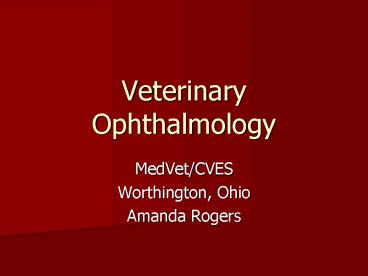Veterinary Ophthalmology PowerPoint PPT Presentation
1 / 23
Title: Veterinary Ophthalmology
1
Veterinary Ophthalmology
- MedVet/CVES
- Worthington, Ohio
- Amanda Rogers
2
- MedVet/CVES is a specialty and 24-hour veterinary
emergency care facility - With a staff of over 25 veterinarians, including
over a dozen specialists - The largest private veterinary referral/emergency
center in the Midwest
3
- CVES operates as an emergency practice only
- No routine veterinary preventative care is
offered - Vaccines
- Heartworm or flea preventative
- Yearly wellness exams
4
- MedVet operates on referrals only
- From your family veterinarian
- From a CVES doctor
- With difficult cases many private practice
veterinarians refer their patients to a
specialist for a more complete and diagnostic
workup
5
Veterinary Specialists
- Cardiology
- Ophthalmology
- Internal Medicine
- Surgery
- Radiology
- Oncology
- Neurology
- Dermatology
- Dentistry
- Specialists are required to complete internship
and residency programs typically 3 to 5 years. - Specialists receive board certification by
fulfilling clinical training, research,
scientific publications, and extensive
examination.
6
Ophthalmology
- Entire focus is on prevention and treatment of
ocular diseases - Most patients referred by their regular
veterinarian
7
Initial Evaluation
- Pertinent ocular and related health history
- Duration of problem
- Medications presently, or recently,
administered - Previous related ocular or systemic diseases
- All pertinent information from your regular
veterinarian is reviewed
8
Basic Examination
- Evaluations of vision Menace
Pupillary Light Reflexes - Ability to navigate in a room
- Schirmer Tear Tests
- Eye Stains Fluorescein
Rose Bengal - Tonometry
- Slit Lamp Examination
- Ophthalmoscopy
9
Frequent Cases
- Glaucoma
- Cataracts
- Cherry eye
- Ulcers
10
Glaucoma
- Intraocular pressures (IOPs) are gt20 mm Hg
- This is a blinding disease
- Caused by trauma or genetics
- Lifelong treatment
11
Glaucoma
- Painful disease
- Even with treatment most cases eventually result
in the loss of one or both eyes - Enucleation
- ISP placement
12
Enucleation
- An eye is completely removed due to an ocular
disease or trauma to the eye - The lids are cut and sewn shut and the pet looks
like it is winking
13
ISP
- An incision is made in the eye and the inner
contents removed - A silicone ball is placed inside and the eye is
sewn shut
14
ISP
- ISPs are placed for cosmetics only
- The pet has no vision as a result from the
implant - The outside of the eye is still subject to
abrasion and disease
15
Cataracts
- The lens of one or both eyes becomes dense and
the animals vision is restricted - Causes
- Diabetes
- Heredity
- Trauma
- Retinal detachment
16
Cataract screening
- Evaluation of candidacy
- Ocular ultrasound
17
Cataract screening
- ERG tests for retinal function
- If the retina in not functioning the patient will
not see, even with the cataract removed
18
Cataract surgery
- The patients lens is removed
- An artificial lens is placed for optimum vision
- Patient is able to see immediately after surgery
19
Cherry Eye
- Genetically caused
- Certain breeds have a high incidence
- Bulldogs
- Must be corrected surgically
- Predisposes the patient to dry eye
20
Ulcers
- An abrasion to the eye
- Many possible causes
- The eye is stained to identify the extent of the
ulcer - Most are treated medically, but some require
surgery
21
Ulcers
- With deep ulcers the eye may rupture without
surgical correction
22
Daily Activities
- Evaluate patients during appointments
- Prepare animals for surgery
- Monitor patients during procedures
- Assist in surgical procedures
- Cataract surgery
- ISP placement
23
Experience
- Gained a tremendous amount of knowledge in
veterinary ophthalmology - Formed contacts
- Expanded veterinary school application
- Experiences that many veterinarians dont have

